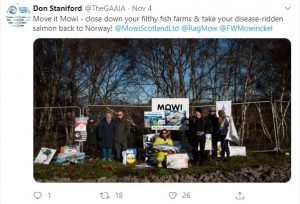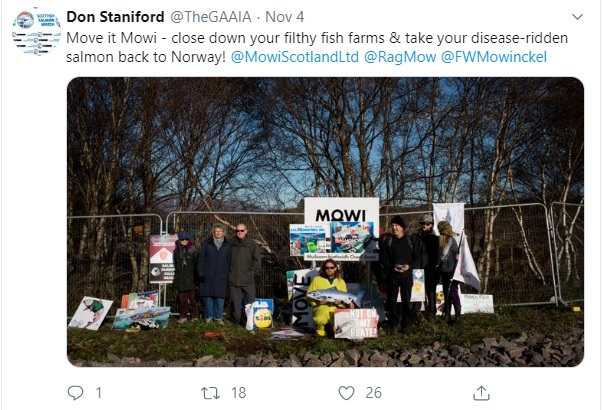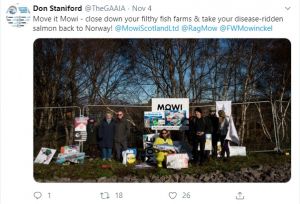Canada: The British Columbian salmon farming industry has been the subject of much scrutiny in recent years as activists claim that it is responsible for declines of wild Pacific salmon. For many years, activist Alexandra Morton maintained that sea lice from salmon farms in the Broughton Archipelago were killing migrating salmon smolts. A number of scientific papers have been published that appear to support Ms Morton’s claims and these have been given maximum publicity.
Unfortunately, other scientific papers have not been highlighted in the same way and because they are not cited, they fall into obscurity, even though they offer a much different insight into the relationship between farmed and wild salmon. We have just come across one such paper that now deserves our attention.
The paper, written by Kenneth M Brooks, appeared in Reviews in Fisheries Science in 2005. The paper looks at the effect of salinity on the survival and distribution of infective sea lice from salmon farms in the Broughton Archipelago. The paper is nearly thirty pages long and considers a variety of scenarios, but the hydrodynamic study reveals that from June to November the top 25 to 40 metres of the water column flowing towards the open sea typically has a salinity of between 15 and 25%. This is because of significant amounts of freshwater entering the system during these months. This low salinity provides a natural control of infective sea lice around the archipelago at a time when the pink salmon are migrating to sea. This is because larval sea lice do not develop at salinities below 30%. The conclusion is that there is little potential for salmon farms to infect migrating smolts as they swim past.
British Columbia is currently closing down seventeen farms in the Broughton Archipelago to provide farm free corridors to help protect and restore wild salmon stocks. Stocks of Pink salmon in the area remain relatively healthy, although sockeye numbers are down. However, according to the Vancouver Sun, sockeye numbers have fallen across all of British Columbia, even in areas where there is no salmon farming. The Blob, an unusually warm patch in the Pacific is blamed for the declines along with climate change in general. Sockeye spend much longer in freshwater than Pink salmon and the freshwater environment has been subject to extremes of flooding and drought.
Unfortunately, it is much easier to lay the blame at salmon farming’s door rather than look at all the factors influencing salmon lifecycles. Sadly, we suspect that those campaigning for the closure of salmon farms will find that once these seventeen farms have gone, the recovery of some salmon stocks will simply not happen.
Damp squib: Readers of the West Highland Free Press may have come across an advert in a recent issue of the paper. This was notification of a protest taking place on Halloween outside the new Mowi feed mill on the Isle of Skye. Unfortunately for the organisers, the advert was completely ignored. At the specified time, no-one from the local area turned up. As video footage clearly shows the protest was attended by a total of six people – Don Staniford of Scottish Salmon Watch, his wife and his two very young children, all from the Wirral in England and Andrew Holder of Extinction Rebellion from Oban together with his partner. They had persuaded some journalists to attend – from a German Magazine and National Geographic and after having had their photos taken, the protest largely disbanded. Four days after the protest, Mr Staniford finally posted a photo of the event showing seven adults in all.

The absence of large numbers of local people, or in fact any other people than the usual suspects, clearly confirms that the anti-salmon farming lobby is very small indeed. However, they are extremely able in interacting with the media. Far too much credibility is given to this vocal minority, but this is because too little effort is made to discount their claims. The protest was live-streamed, and it was extremely evident from the conversation broadcast that the protestors know little about the salmon farming industry. Currently, the anti-salmon farming lobby make much of the published mortality data and some out of context photographs in the hope that they will repulse consumers. They also say that such mortality would never be tolerated in other industries. The problem with using total mortality figures is that they cover the whole industry. The implication is that all the fish deaths are of harvestable size fish when in fact many are small hatchery fish. Fish produce many eggs because most die as they hatch and grow.
This week the Guardian newspaper reported that the World Organisation for Animal Health has said it expects a quarter of the world’s farmed pig stock to die from African swine fever. Already more than 100 million pigs have succumbed to the disease and this number is expected to increase to about 350 million. Some countries are already culling their stocks to prevent the spread of the disease. It is also important to point out that many of the affected farms are not what the critics would call industrial factory farms. It seems that terrestrial farming can suffer unexpected loss too.
Lice: The other vocal salmon farming critic, Corin Smith, has posted a video and a commentary about sea lice on his Facebook page. He repeats the ‘accepted’ commentary about salmon farming and sea lice. He says that a single salmon farm of 1,000 tonnes with a sea lice count of 5 per fish can produce upwards of 3 billion sea lice larvae a month and these can be dispersed over an area of up to 19 miles. He adds that research has shown that just 12 sea lice are enough to kill a juvenile wild salmon migrating past a salmon farm.
We, at Callander McDowell, have previously written about this suggestion that just 12 sea lice can kill a migrating Atlantic salmon. Clearly, as fish have been caught in the wild with lice numbered in hundreds, that appear otherwise healthy this number of 12 must be questioned. The review commissioned by Salmon & Trout Conservation from NINA in Norway attributes this number to a paper by Wells and others from 2006. It is only necessary to read the title of the paper to wonder about the merit of these claims. The paper is titled ‘The physiological effects of simultaneous abrupt seawater entry and sea lice infestation of wild sea trout smolts’. This laboratory experiment does not just focus on sea lice but also looks at the impact of transfer to sea water which places extra stress on the fish. The findings of the paper bear little resemblance to young salmon migrating past a salmon farm.
Many of the views about sea lice are based on supposition rather than hard fact. We know that lice produce planktonic larvae but whether they spread throughout the marine environment in their billions is unclear. What is known is sampling of sea trout by various fishery trusts results in the capture of small numbers of fish some of which have very high lice numbers. It is assumed that this sample is representative of the total population but as we have indicated, sea lice, like other parasites, follow an aggregated distribution with a small number of hosts carrying large numbers of parasites whilst the majority of the hosts are infested with very few, or none at all.
Mr Smith talks of billions of larval sea lice being dispersed through the marine environment yet doesn’t explain how these larvae connect with their host. Most parasites are extremely specific in the way they find their host. It makes no sense, that the lice larvae would simply drift in the open sea leaving it to chance to find a host.
Emily Nelson and her colleagues sampled for larval sea lice around salmon cages up to a distance of 100m away. Densities of lice nauplii were high in the cage but fell away sharply to low levels. The researchers concluded that whilst salmon farms may be a source of sea lice, the early life stages remain close to the cages forming a self-sustaining population.
Costelloe and others measured the planktonic larvae at various distances from the cage. They found the highest densities within the cage at about 66/m3. At 10 metres from the cage, the density had fallen to 4.8/m3 and at one-kilometre distance, the density was just 0.4/m3. Clearly at a distance of 19 miles, the density of lice would be negligible.
The same researchers have also measured lice using drogues at Killary Harbour on the west coast of Ireland. They found that the larvae from the farm were washed out to the open sea and that there was no evidence that any of the large numbers of the larvae that they found within the harbour had come from the farm. In a later work, they concluded that these larval lice had originated from wild fish not farmed.
Shona Marshall, working on the west coast of Scotland found that there was a high lice abundance in the spring when salmon and sea trout smolts were migrating to sea even when the salmon farm was lying fallow with no fish. She concluded that the spring increase in sea lice infestations of wild fish was a natural event.
Whilst Mr Smith asserts that farmed salmon are the source of sea lice, both Costelloe and Marshall concluded that the source of infective larvae was wild fish. The problem is that we know very little about the life cycle of the sea lice. It was only about five years ago that a paper detailed that the accepted view of the salmon louse life cycle was incorrect and that it has just two chalimus stages rather than four. Even now, how the sea lice find its host in the vastness of the ocean is still considered a mystery to scientists as the Marine Institute in Ireland have clearly highlighted on their website.
We, at Callander McDowell, would argue that far from researching the impact of sea lice from salmon farms on wild fish, research should be targeted at understanding how sea lice find their hosts in the wild. As we have pointed out, lice do not leave finding a host to chance. It would seem that naturally occurring lice from wild fish aggregate at river mouths in anticipation of finding a host.
Whilst most sea lice work focusses on the west coast, in 1998, MacKenzie and colleagues compared the prevalence of sea lice from 15 sites around Scotland including the east coast. The fourth and fifth most prevalent sites were the River Eden (67%) and the River South Esk (61%). Nine west coast sites at distances of less than 14 km from a farm had a prevalence that was much lower, less than 20%, than that found in these east coast rivers. These two rivers were hundreds of kilometres from any salmon farms, yet the researchers found a high prevalence of sea lice. Clearly, this had nothing to do with salmon farming.
Sadly, many within the wild fish sector are not interested in such long-standing research because it doesn’t fit in with their narrative about the alleged damaging effects of salmon farms. Instead, we get to hear the same much-repeated stories, such as that prompted by Corin Smith, about billions of sea lice in the sea because that is the view that they want to promote. The research is as valid today as when it was published but unless the work continues to be cited in new papers, it soon gets forgotten. Since much of new research is aimed at showing the negative impacts of salmon farming, these papers are largely ignored, but as we have shown, not forgotten.
Dredging it up: Channel 4 News recently broadcast a story from the west coast of Scotland about illegal dredging of scallops in protected areas. The programme showed how the dredgers damaged the seabed destroying everything in their wake.
Clearly it would seem that the best way to protect the seabed in these fragile areas would be to ban dredging and trawling in the vicinity. However, as the news story showed, it is very difficult to police the sea, especially when it is acceptable to dredge in some areas but not in other areas nearby.
Perhaps the only solution is to ban all trawling and dredging through the reintroduction of the three-mile fishing limit allowing such inshore water to be harvested by small fishing vessels and creel fishermen. We recognise that the Government are under pressure to keep these fishing grounds open to larger boats so perhaps a compromise would be a two-mile fishing limit.
We believe that it would not just be the fishermen who would benefit but also anglers who might see a recovery of sea trout. We would argue that trawling has destroyed the marine habitat on which sea trout rely which is why we have seen numbers of this species continue to decline. We suspect that the Government will be forced to close inshore waters eventually, as the last remaining inshore stocks are fished to extinction.
Housing: The Herald newspaper recently reported that rural campaigners have launched a scheme to build new homes specifically for local workers to halt the crippling decline of island communities. The group on the Isle of Arran say workers in vital professions can no longer afford to settle there because of the high cost of property and the lack of affordable homes. This is because much of the property has been bought as second homes by incomers and retirees. The group says that the island now has four villages, known as ‘Dark Villages’, where more than 80% of the houses are second homes.
It is likely that the high number of retirees and second homeowners on Arran is why the island is such a vocal opponent to salmon farming. They are only interested in a quiet life and moved to Arran in the hope of living amongst the landscape and not on a working island. However, without a working population, the only outlook for the island will be to die just like the outlook for the retirees.


